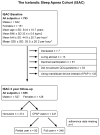Quality of life among untreated sleep apnea patients compared with the general population and changes after treatment with positive airway pressure
- PMID: 25431105
- PMCID: PMC4439289
- DOI: 10.1111/jsr.12262
Quality of life among untreated sleep apnea patients compared with the general population and changes after treatment with positive airway pressure
Abstract
Obstructive sleep apnea leads to recurrent arousals from sleep, oxygen desaturations, daytime sleepiness and fatigue. This can have an adverse impact on quality of life. The aims of this study were to compare: (i) quality of life between the general population and untreated patients with obstructive sleep apnea; and (ii) changes of quality of life among patients with obstructive sleep apnea after 2 years of positive airway pressure treatment between adherent patients and non-users. Propensity score methodologies were used in order to minimize selection bias and strengthen causal inferences. The enrolled obstructive sleep apnea subjects (n = 822) were newly diagnosed with moderate to severe obstructive sleep apnea who were starting positive airway pressure treatment, and the general population subjects (n = 742) were randomly selected Icelanders. The Short Form 12 was used to measure quality of life. Untreated patients with obstructive sleep apnea had a worse quality of life when compared with the general population. This effect remained significant after using propensity scores to select samples, balanced with regard to age, body mass index, gender, smoking, diabetes, hypertension and cardiovascular disease. We did not find significant overall differences between full and non-users of positive airway pressure in improvement of quality of life from baseline to follow-up. However, there was a trend towards more improvement in physical quality of life for positive airway pressure-adherent patients, and the most obese subjects improved their physical quality of life more. The results suggest that co-morbidities of obstructive sleep apnea, such as obesity, insomnia and daytime sleepiness, have a great effect on life qualities and need to be taken into account and addressed with additional interventions.
Keywords: Icelandic sleep apnea cohort (ISAC); Personalized medicine; compliance; mental and physical health.
© 2014 European Sleep Research Society.
Conflict of interest statement
The authors declare no competing interests with regard to the submitted work. Dr. Arnardottir is a consultant for Nox Medical, Inc. Dr. Kuna receives grant support from Philips Respironics. Other authors do not report a conflict of interest.
References
-
- Akashiba T, Kawahara S, Akahosni T, et al. Relationship between quality of life and mood or depression in patients with severe obstructive sleep apnea syndrome. Chest. 2002;122:861–865. - PubMed
-
- Avlonitou E, Kapsimalis F, Varouchakis G, Vardavas C, Behrakis P. Adherence to CPAP therapy improves quality of life and reduces symptoms among obstructive sleep apnea syndrome patients. Sleep Breath. 2012;16:563–569. - PubMed
Publication types
MeSH terms
Grants and funding
LinkOut - more resources
Full Text Sources
Other Literature Sources


